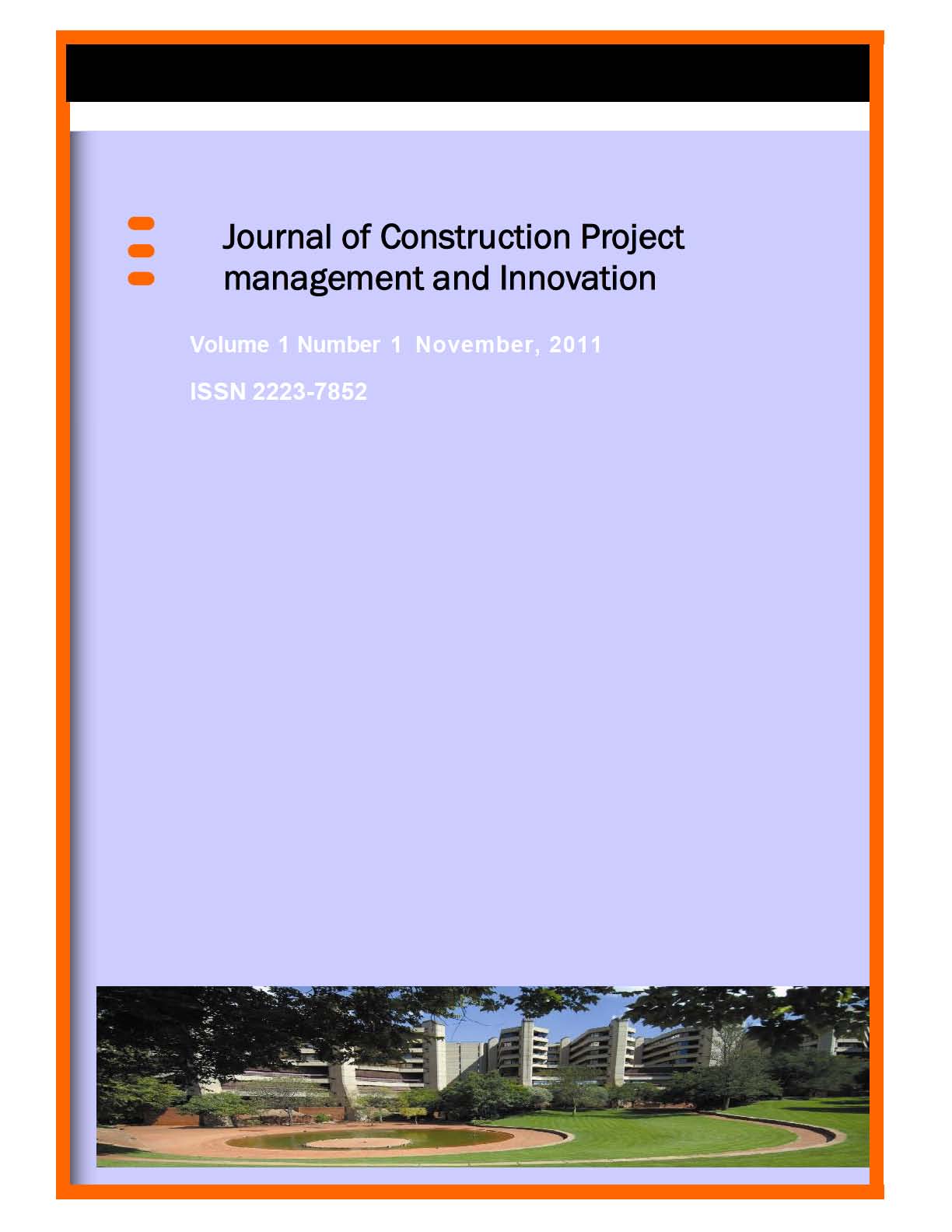AN INVESTIGATION INTO CONTRACTORS’ EVALUATION OF RISKS ASSOCIATED WITH THE JBCC PRINCIPAL BUILDING AGREEMENT IN SOUTH AFRICA
Main Article Content
Keywords
contractors, JBCC (PBA), Identification, Quantification and Classification Framework (IQCF), risk management, South Africa
Abstract
Construction is a risky business, and risk management is an essential responsibility in managing construction projects and organisations. Hence, construction contracts have been developed to organise the relationship between project participants and manage associated risks. This paper provides an investigation into the contractors’ responses and feedback obtained through the application of an innovative framework developed by the authors towards identifying, quantifying and classifying the risks associated with the Joint Building Contractors Committee Principal Building Agreement Series 2000 (JBCC PBA) in South Africa. Qualitative and quantitative techniques have been used in this study for data collection and analysis. Purposive sampling was adopted to identify the respondents, and 9 construction managers were interviewed. The interviews were structured so that they were carried out in a free and unbiased manner and responding contractors were asked to complete a questionnaire. Analysis of responses showed that the developed Identification, Quantification and Classification Framework (IQCF) is an innovative and accepted tool that is able to fill the gap in managing project risks and will complement current practices. It is seen to be of benefit to firms in assisting with training of employees and helping junior employees understands and uses the JBCC (PBA). Investigating the validity and reliability of the developed framework is of prime importance to ensure its suitability to manage risks associated with the JBCC (PBA). For this reason contractor’s responses and feedback are based on the practical application of the framework which ultimately increases its value and contribution to the construction industry. The adoption and application of the framework will enable contractors to enhance the risk-management process in South Africa.
Article Metrics Graph
References
Cartlidge, D. (2009). Quantity surveyor’s pocket book. Butterworth Heinemann is an imprint of Elsevier Linacre House, Jordan Hill, Oxford OX2 8DP, UK.
Clough, R. (1975). Construction contracting. John Wiley & Sons: New York.
Edwards, L. (1995). Practical risk management in the construction industry. Telford Publishers: London.
Edwards, P.J. and Bowen, P.A. (2005). Risk management in project organisations. Butterworth Heinemann: Oxford.
Fellows, R. and Liu, A. (1997). Research methods for construction. Blackwell Publisher Ltd.: London.
Finsen, E. 1999. The building contract: a commentary on the JBCC agreements. Spon Press: New York.
Flanagan, R. and Norman, G. (1993). Risk management and construction. Blackwell Scientific Publications: London.
Gillham, B. (2000). Developing a questionnaire. Continuum: London.
Harinarain, N. (2008). Identification, quantification and classification of risks pertaining to building contractors in the JBCC (Principal Building Agreement). M.Sc. Thesis. University of KwaZulu Natal: South Africa.
Harinarain, N. and Othman, A.A.E. (2007). A framework for identifying, quantifying and classifying risks associated with the Principal Building Agreement in South Africa. In: Proceedings of the 2nd Built Environment Conference, Port Elizabeth, South Africa, 17 19 June, pp. 138 151.
Kometa, S.T. and Olomolaiye, P.O. (1997). Evaluation of factors influencing construction clients' decision to build. Journal of Management in Engineering, ASCE, 3(2): 77 86.
McNeil, P. and Chapman, S. (2005). Research methods. 3rd edition. Routledge: London.
Miles, J.C., Moore, C.J., Kotb, A.S.M. and Hamedani, A.J. (2000). End user evaluation of engineering knowledge based systems. Civil Engineering & Environmental Systems, 17 (4): 293 317.
Ng, S.T. and Smith, N. (1998). Verification and validation of case based prequalification systems. Journal of Computing in Civil Engineering, ASCE, 12(4): 215 225.
Olomolaiye, P.O., Price, A.D.F. and Wahab, K.A. (1987). Problems influencing craftsmen’s productivity in Nigeria. Build Environment, 22(4): 317 323.
Othman, A.A.E. and Harinarain, N. (2009). Managing risks associated with the JBCC (Principal Building Agreement) from the South African contractor’s perspective. Acta Stuctilia, Journal for the Physical and Development Sciences, 16 (1): 83 119.
Ren, Z. (2002). A multi agent systems approach to construction claims negotiation. Ph.D. Thesis. Loughborough University: UK.
Saunders, M., Lewis, P. and Thornhill, A. (2003). Research methods for business students. Prentice Hall: Harlow.
Sawczuk, B. (1996). Risk avoidance for the building team. Spon: London.
Shutt, C.A. (2007). Assess strengths, weaknesses, opportunities and threats to keep your company focused on success. [Online] Available from: http://forpros.lowes.com (Accessed: 23 April 2011).
Smith, N.J. (1998). Managing risk in construction projects. Blackwell Scientific Publications: Great Britain.
Tashakkori, A. and Teddlie, C. (1998). Mixed methodology, combining qualitative & quantitative approaches. Sage Publications: London.
Uff, J. (1981). Construction law: an outline of law and practice relating to the construction industry. Sweet & Maxwell: London.
Van Deventer, R. (1993). The law of construction contracts. Chancery Wiley Law Publications: Chichester. John Wiley & Sons Ltd: Dunfermline.

